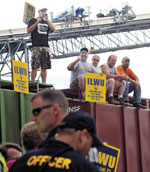
Showdown on West Coast Docks: The Battle of Longview
(November 2011).
click on photo for article
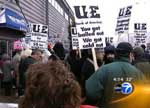
Chicago Plant Occupation Electrifies Labor
(December 2008).
click on photo for article
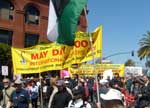
May Day Strike Against the War Shuts
Down
U.S. West Coast Ports
(May 2008)
click on photo for article
November 2012
After 55 Days on
Picket Line, a Solid Labor Victory
Including Union Hiring Hall!
With Groundbreaking Contract
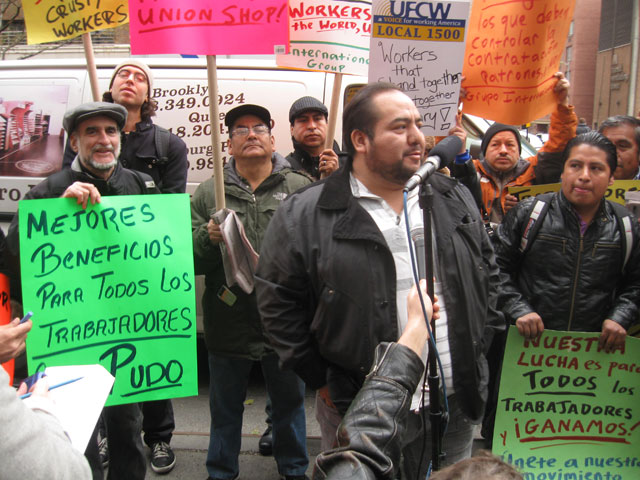
Mahoma López of the Hot and Crusty Workers Association speaking at November 16 press conference announcing the union victory in winning a contract including union control of hiring.
(Internationalist photo)
After months of struggle, immigrant workers at the Hot and Crusty bakery/restaurant on Manhattan’s Upper East Side have made big news for the workers movement. A solid union victory – including a union hiring hall and benefits virtually unheard of in the industry – has come through a fight that captured the attention of labor activists throughout the city and beyond. Dramatic ups and downs marked the campaign from the start, but the workers’ determination to “seguir hasta las últimas consecuencias” – to stick it out, come what may – was crucial to winning this battle. The inspiring outcome has the potential to spark further, wide-ranging efforts to organize low-wage immigrant workers throughout the food industry in New York City, “the restaurant capital of the world.”
On October 23 the Hot and Crusty Workers Association (HCWA) signed a contract with new owners of the 63rd Street restaurant. A union press statement notes that the workers “will return to the job under a new collective bargaining agreement that provides for union recognition and a union hiring hall, paid vacation and sick time, wage increases,” as well as seniority and a grievance procedure. Having won advances that set a new precedent for foreign-born restaurant workers, organizers “are eager to build on this momentum,” stated the Laundry Workers Center (LWC). The Hot and Crusty workers, mainly immigrants from Mexico and Ecuador, invited the New York-based activist group to help them build the campaign, which they launched in late 2011 in response to years of abuse from the former owners of the lucrative East Side locale.
“We Will Go Through to the End”
As reported by The Internationalist (“‘Hot and Crusty’ Workers Show the Way,” 8 September 2012), the unionization campaign emerged from the workers’ resistance to conditions all too typical of workplaces in New York and around the country in which employers pay immigrants less than the legal minimum wage, deny them all benefits, oblige them work when sick or injured on the job, and threaten to fire them if they protest. Fed up with abuse and workweeks in some cases of 60 hours or more and even up to 72 hours without overtime pay, Hot and Crusty employees got no response when they called the New York State Labor Department. With aid from the LWC and the Eisner & Mirer labor law firm, they sued the company, eventually winning back pay, and undertook a carefully planned campaign to build a union.
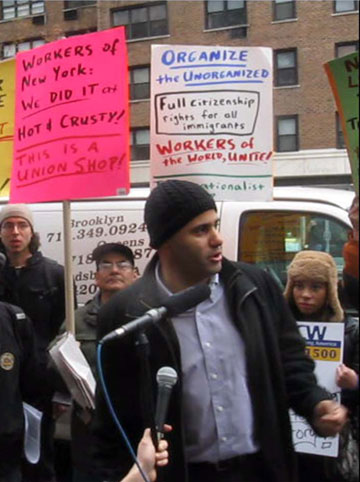 Virgilio
Aran of the Laundry Workers Center, at
November 16 press conference. “A victory
for all workers.” (Internationalist
photo)
Virgilio
Aran of the Laundry Workers Center, at
November 16 press conference. “A victory
for all workers.” (Internationalist
photo)
Deploying a panoply of dirty tricks from the anti-labor playbook, the company hired a union-busting consultant (a former labor bureaucrat who found greener pastures working directly for the other side), brazenly bought off a worker who had initially helped launch the campaign (promising him a share in the profits), threatened to call the “Migra” immigration cops, and tried to pad the lists of those eligible to vote on union recognition by bringing in relatives and “reliable” former employees. To the bosses’ surprise, however, the HCWA won hands-down when representation elections were held in May.
Yet rather than negotiate, the former owners closed the shop on August 31, leading to an hours-long protest occupation by Occupy Wall Street supporters, six of whom were arrested for their solidarity action. The workers then set up a picket line, organized in two shifts from eight every morning to eight at night, and were joined by supporters, notably adjunct faculty and students from nearby Hunter College, where Class Struggle Education Workers activists won early support for the cause from the faculty/staff union, the Professional Staff Congress-CUNY. (The PSC chapter organized an on-campus solidarity event on October 3 to help build solidarity for the union brothers and sisters at Hot and Crusty.)
A dramatic turn came on September 8: at a rally of union supporters HCWA spokesman Mahoma López announced that prospective new owners had signed a tentative accord agreeing to union recognition and a union hiring hall. This was “a groundbreaking and potentially historic step forward,” we wrote, while stressing, as López and other workers noted, that “the struggle is not over.” Indeed, yet another turn in the situation came a week later when the workers were told that the building’s owners were refusing to sign a lease that would permit the restaurant’s reopening. “Feels like a roller coaster,” one union supporter said – but the workers went right back on the picket line. Soon enough, an anti-union restaurant chain made a foray aimed at exploiting the situation, but withdrew in a hurry when faced with determined opposition from union supporters and solidarity activists.
As days turned into weeks, it was clear that persistence was key; no flash in the pan, the struggle required the hard core of union supporters sticking to their guns, showing they would not be starved into submission, while working to mobilize solidarity from broader sectors of the labor movement. As an Internationalist supporter in the supermarket workers union noted – and as attested by a long chain of defeated organizing efforts in the New York food industry – winning union rights would be far easier “were it not for the union bureaucracy, whose torpid complacency is an expression of their acceptance of second-class status for immigrant workers.”
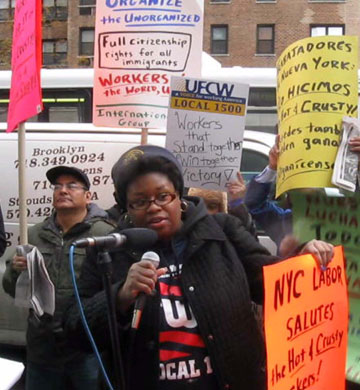 Christine
Williams of Transport Workers Union Local
100 Executive Board. “Immigrant workers gave a lesson:
if we stick together, we can win.”
Christine
Williams of Transport Workers Union Local
100 Executive Board. “Immigrant workers gave a lesson:
if we stick together, we can win.”
(Internationalist photo)
Determined efforts were made
to expand support, and on October 18 a
“Labor/Immigrant Rights Rally” in solidarity
with the Hot and Crusty workers drew a hundred
enthusiastic participants, including
representatives and activists from some of the
city’s largest unions. These included subway and
bus workers (TWU Local 100), Verizon phone
workers (CWA Local 1101) and power workers from
Con Ed, city workers from AFSCME DC 37, the
predominantly immigrant Laborers Local 78 and
Jornaleros (day laborers), supermarket and
restaurant workers (UFCW,
UNITE-HERE, ROC-NY), teachers (UFT, PSC-CUNY),
and others. As Virgilio Aran of the Laundry
Workers Center told the rally, “This is an
example to all workers in New York City, and
to every union. Even though we are winning, we
are going to continue organizing workers in
laundries and in restaurants” (see “NYC
Unions Back Hot and Crusty Workers at
Labor/Immigrant Rights Solidarity Rally,”
19 October).
The daily picket continued – with no strike fund, yet the workers held firm. Getting the word out at other restaurants and pizza parlors, they faced intimidation tactics from police, who took photos, demanded to see ID, and at one point made up a supposed “law” against putting picket signs on cardboard tubes (!). After two weeks on the line, voices from the bosses’ camp grew louder in insisting that it was time for the workers to call it quits – but they didn’t buckle. In the second week of October, an attempt was made to stampede them back to work without the union hiring hall. Firmly rejecting this, the workers voted once again to continue the struggle. This reaffirmation of their hard-edged resolve marked a crucial moment in the campaign. “We felt it was all or nothing for us,” one recalls; “we vowed we would go through to the end.”
And after 55 days on the picket line, they won! On October 25, news of the contract’s signing reached the corner of 63rd Street, as workers held up signs reading “We Did It!” Symbolic of the impact, a cacophony of horn-honking ensued as truck and cab drivers saw the signs and signaled their approval. For the working class of New York, this small group of immigrant workers had made some big news indeed. As the message of this victory spreads, it has the potential to spark major new struggles.
Class and Race in the City
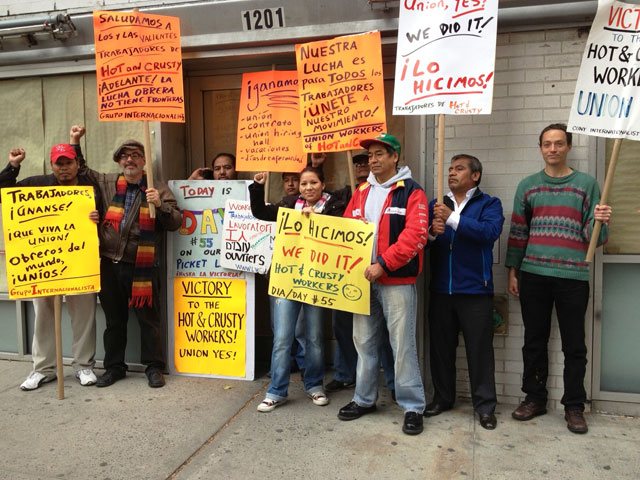
October 25, Day 55 on the picket line. “We
did it! Our struggle is for all
workers.”
(Internationalist photo)
Manhattan’s posh Upper East Side might seem an unlikely scene for a hard-fought union struggle, yet it provides a telling microcosm of class and race in the city. Passing the picket line on the sidewalk every day, black Caribbean nannies pushed white babies in strollers; Latino UPS men and Chinese laundry workers rushed to make deliveries; an elderly Italian shoe repair man stopped by every day to share some pan dulce (Mexican pastry); a young African American messenger came up to say “we need a union where I work” and ask how he could set about starting one. Dozens of Mexican “delivery boys” (in reality men up to 50 years old) paused when bicycling past at the picket.
At first they simply looked it over from a distance, but as the weeks went by increasing numbers ventured over to talk about how bad things are at their own workplaces. Since Second Avenue is a major thoroughfare – for countless delivery and repair vehicles as well as cabs and the MTA – hundreds of truck, bus, van and cab drivers saw the picket each day, and many of them made a point of honking in solidarity. (One young Hunter adjunct who came often to the picket line observed that the enormous trucks using their air horns to blast this message of solidarity could help dispel armchair academics’ hot air about the alleged “disappearance” of the working class.)
Innumerable neighborhood workers – and a good number of residents – had encouraging words for the Hot and Crusty pickets, and hundreds stopped at the picket table to sign petitions or drop bills into the donation canister. Yet some upper-crust denizens tried hard to demoralize the workers, who had to endure haughty ladies and gentlemen railing against unions or yelling “Get a job!” As picket-line stalwart Margarito López recalls, “Every day they kept asking us, ‘What are you still doing here?’” The restaurant was “closed forever, you’re never going back,” others lectured the workers. Enraged by a picket sign reading “Honk to Support Workers Rights at Hot & Crusty,” one local yuppie assaulted the comrade holding the placard, ripping it to pieces while shrieking threats and abuse.
Worse still were the bigots who vituperated against “illegal immigrants” (though as one union supporter noted, “they don’t ask for your papers when they come in to buy a danish – just when you start fighting for your rights”). Here a glimpse of multiracial workers power was instructive. For several weeks, a crew of workers from Con Ed, as well as specialized contractors, was at the corner of 63rd repairing underground gas and electric lines. One morning a well-dressed white man began screaming anti-immigrant epithets at Hot and Crusty workers on the picket line. Two Afro-Caribbean road crew workers suddenly appeared with a large metal crowbar and started fiddling with a manhole cover right next to the bigot, who promptly turned tail. Approached by a union supporter who thanked them for their quiet but effective solidarity, one said, “yeah, that guy was an asshole” – “a racist asshole,” his coworker agreed, adding: “We’re all immigrants here when you get down to it.”
Need and Potential for
Class-Struggle Organizing
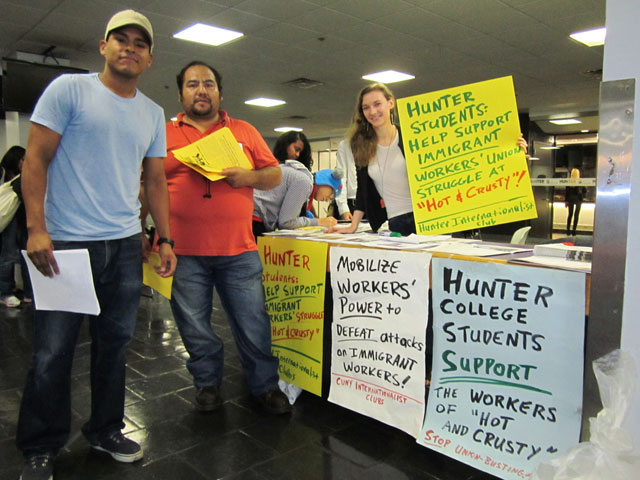
Tabling at Hunter College, September 27. CUNY Internationalist Clubs used forums, class visits, items in student papers to help build support for Hot and Crusty workers. (Internationalist photo)
That the Hot and Crusty struggle fired the imagination and hopes of many, while enraging others across the class divide, is due in good part to the way it drew attention to the enormous potential for wide-ranging, militant organizing among immigrant workers in New York and beyond. Super-exploited, doubly and triply oppressed and largely disenfranchised, these workers – mere raw material for exploitation from the standpoint of the ruling class – could be sparked into struggle by even a localized victory. The potential for a massive campaign to organize the unorganized is underscored by other efforts by low-wage workers that overlapped with the events at Hot and Crusty. A successful organizing drive by car wash workers in the Bronx and Queens made headlines in the New York Times – while unprecedented protest/strike actions have broken out at the notorious Wal-Mart chain.
With an estimated 165,000 workers in its food service sector, New York City is home to fifteen thousand eating and drinking establishments, generating fabulous profits. (Revenues for 2010 were projected at over $15 billion.) The secret to success in “the restaurant capital of the world” – from the corner pizza parlor to the latest food-blog phenomenon, on up to the Michelin/Zagat stratosphere – is super-exploited immigrant labor. Seventy percent of NYC restaurant workers are immigrants, drawn from a very wide range of countries throughout the world, at least 40 percent of whom are undocumented. It is to these workers that the most dangerous, ill-paid and dirty tasks are assigned: toting endless heavy crates up and down the stairs to dank cellars; cutting, slicing and dicing meat and vegetables; handling super-heated pizza ovens, saucepans and sprayers; washing dishes and jockeying delivery bikes through heavy traffic. Injuries are commonplace, but like paid vacations, sick days are virtually unheard of – less than 10 per cent of the restaurant workforce has them.[1]
The industry’s demographics highlight the potential impact of the victory at Hot and Crusty. Like the workers there, a strikingly large proportion of New York food workers come from Puebla, Guerrero, Tlaxcala and other Mexican states ravaged by the North American Free Trade Agreement. Signed in 1994 under Democrat Bill Clinton, NAFTA drove millions from predominantly peasant regions p’al Norte as migrant proletarians. One result is New York’s large Mexican-origin population, which grew almost 58% from 2000 to 2007 alone, and is presently estimated at close to 300,000. Also relatively recent, large-scale immigration from places like Bangladesh, Ecuador and West Africa links up with large populations from the Caribbean, China, India/Pakistan, Eastern Europe and elsewhere in a city where 37 percent of the population (roughly 3 million out of 8 million-plus) consists of immigrants, concentrated in the working class (46 percent of the labor force), particularly in the low-wage sector.[2]
Facing arrogant employers used to having their way in a business where brutal abuse and starvation wages are the norm, a strategy based on the logic of class struggle offers the only real hope of success. While capitalist politicians and media spew xenophobia against immigrant workers, “condescending saviors” of various descriptions approach them like helpless victims, or a passing cause célèbre for liberal do-gooders. For revolutionary Marxists, in contrast, the growing immigrant sector of the U.S. working class forms a vital human bridge to some of the most volatile parts of the planet, while enriching the workers movement here with experience from around the world. Relying on the workers’ struggle, unchained from its subjugation to Democrats and Republicans, class-struggle unionism can reverse the pattern of labor retreat. With an impact far beyond one New York restaurant, the Hot and Crusty workers' victory illustrates the potential for a militant workers movement.
Calling for full citizenship rights for all immigrants in the struggle for socialist revolution, since our inception the Internationalist Group has been virtually unique on the left in systematically winning workers from this dynamic sector, to become cadres in building the nucleus of a genuinely internationalist and revolutionary workers party. This helps explain an aspect of the Hot and Crusty campaign that observers often noted but did not always “get”: the role of the relatively small, Trotskyist IG, not just as daily picket line participants but also (for example) as organizers of labor and student support in the struggle for a solid union victory.
At the same time, the Hot and Crusty campaign has been an important experience for our organization’s supporters, who combined their picket duty with intensive study of lessons from past struggles, such as the organizing campaigns described in Teamster Rebellion, Farrell Dobbs’ classic account of the Trotskyist-led Minneapolis strikes of 1934 that helped pave the way for the explosive rise of mass industrial unions in the midst of the Great Depression. Linking these lessons to today’s struggles is an example of how the revolutionary party helps serve as “the memory of the working class.”
Given the divide-and-conquer tactics used by bosses everywhere, immigrant worker activists of the Internationalist Group also emphasized the need to counteract national/ethnic divisions (notably between Latinos and Asians). Prominently featured at the picket line was an LWC placard reading “Workers united,” with the word workers in Arabic, Chinese, English, Filipino, French, Hebrew, Italian, Japanese, Korean, Portuguese, Russian, Spanish and Turkish. IG activists laid particular stress on the inseparable connection between immigrant rights and the fight for black liberation through socialist revolution in this deeply racist country that was founded on chattel slavery. The need for proletarian opposition to capitalist politicians of every variety was a point our comrades emphasized during innumerable discussions over past weeks, dominated as they were by elections in the U.S. as well as Mexico. Just after the Hot and Crusty win came Hurricane Sandy, with HCWA and LWC members participating in relief efforts in some of the worst-hit areas. The storm’s ravages showed anew just how deadly are the grotesque inequalities of class and race. “It is really shocking how people were just abandoned, in a country we’re always told is the center of the ‘First World’,” one Hot and Crusty worker remarked after spending the day clearing rubble in Far Rockaway.
“A Struggle for All the
Workers”
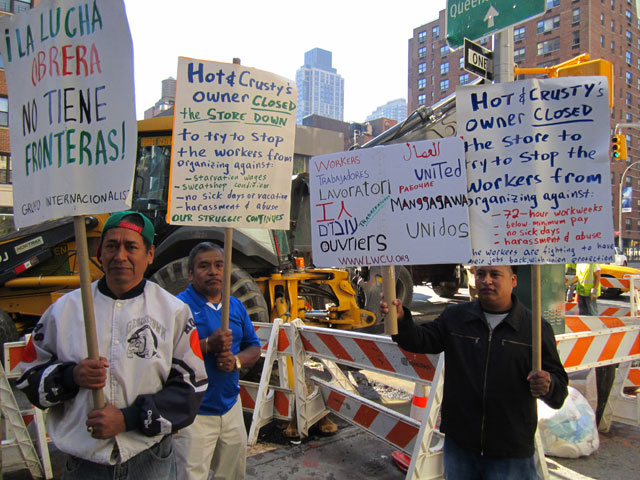
Determination on the picket line, September 25. Sign called for unity of workers, with new languages being added as the struggle continued. (Internationalist photo)
“Esta lucha es para todos los trabajadores” (This is a struggle for all the workers). Inviting others to join the fight, this slogan from placards at the 55-day picket line expressed a sentiment often voiced by the Hot and Crusty workers. Commenting on the settlement, Mahoma López said: “The workers are feeling really excited about this news because this is more than just a contract for us. We are putting an example out there for other workers.... We want others to take this victory to their own workplaces so we can make change in this country.”
At a meeting where the union victory was discussed, HCWA activists said the fight had changed them forever, and spoke of their proud belief that others will be inspired by their example. “We stood up, we fought and won this battle, but the workers struggle is a war that will continue,” one older worker observed. With one after another powerfully describing the meaning of the campaign, long-time Hot and Crusty dish washer Margarito López summed up:
“Despite everything that
happened to us in this fight, we remained there
[on the picket line] and never gave up. And so
long as workers are being exploited, we have to
be there with them, to support them, in line
with our ideals.... We always said that we could
win this struggle, but only if we stayed united.
Every worker must become conscious of our common
struggle, and of how we must push it forward
together. The fight does not stop here, because
all of the companies want to keep on exploiting
us all. This is the moment for the workers to
wake up, to cast off the darkness they keep us
in, because as workers and as immigrants, our
rights will never come as some kind of gift from
any boss. We won a contract because we stuck it
out, and we are going to continue in the
struggle.”
[1] Restaurant Opportunities Center of New York and New York City Restaurant Industry Coalition, Beyond the Kitchen Door: Pervasive Inequality in New York City’s Thriving Restaurant Industry (January 2005); Robert Wood Johnson Foundation, “NYC’s Immigrant Restaurant Workers Get Information and Resources” (25 February 2011).
[2]
CUNY Center for Latin American, Caribbean
& Latino Studies, “Mexicans in New York
City, 2007: An Update” (December 2008); Fiscal
Policy Institute, Working
for a Better Life: A Profile of Immigrants
in the New York State Economy (November
2007).
|
Message
from International Longshore and
Warehouse Union (ILWU) Activist
Jack Heyman
October 30, 2012 To the Hot and Crusty Workers Association, NYC: Union brothers and sisters, From the docks of Oakland we send you greetings of workers solidarity – and congratulations for the struggle you have waged. Winning union recognition, a union hiring hall and a first union contract, you've continued on the proud, historic path of class struggle in this country and show the way for other militant workers’ victories. They tried to stop you, but they couldn't: that is the fresh lesson of workers solidarity that you have given. Standing strong on the picket line for 55 days, you stood up to attempts to intimidate you, wear you down, demoralize you or starve you out. You didn't have a strike fund, but you had something even more important: perseverance and the determination to win a solid union victory. It was this that brought out over 15 of New York’s most important unions to back your fight in last Thursday’s [October 18] Labor/Immigrant Rights Rally in Solidarity with the Hot and Crusty Workers. As mentioned in the message I sent eight weeks ago, West Coast longshore workers won the union hiring hall through the 1934 general strike and battles in which police killed three of our union brothers. In the fight for workers power, we learned the hard way that the government, courts and cops are on the bosses’ side. But our side has something even more powerful: the fact that without our labor, nothing moves and we can bring it all to a halt when we organize to use our power as a class. And in that fight, who does or does not have “papers” matters not one damn bit – “La lucha obrera no tiene fronteras!” Or put another way: Asian, Latin, black and white – Workers of the world, unite! Your example can and must spread. Your stunning victory will inspire others to fight. Organize the unorganized – full rights for all immigrants – let’s build on this victory! – Jack Heyman, ILWU longshore organizer of the 2008 May Day strike against the war and chair of the Transport Workers Solidarity Committee |
To contact the League for the Fourth International or its sections, send an e-mail to: internationalistgroup@msn.com